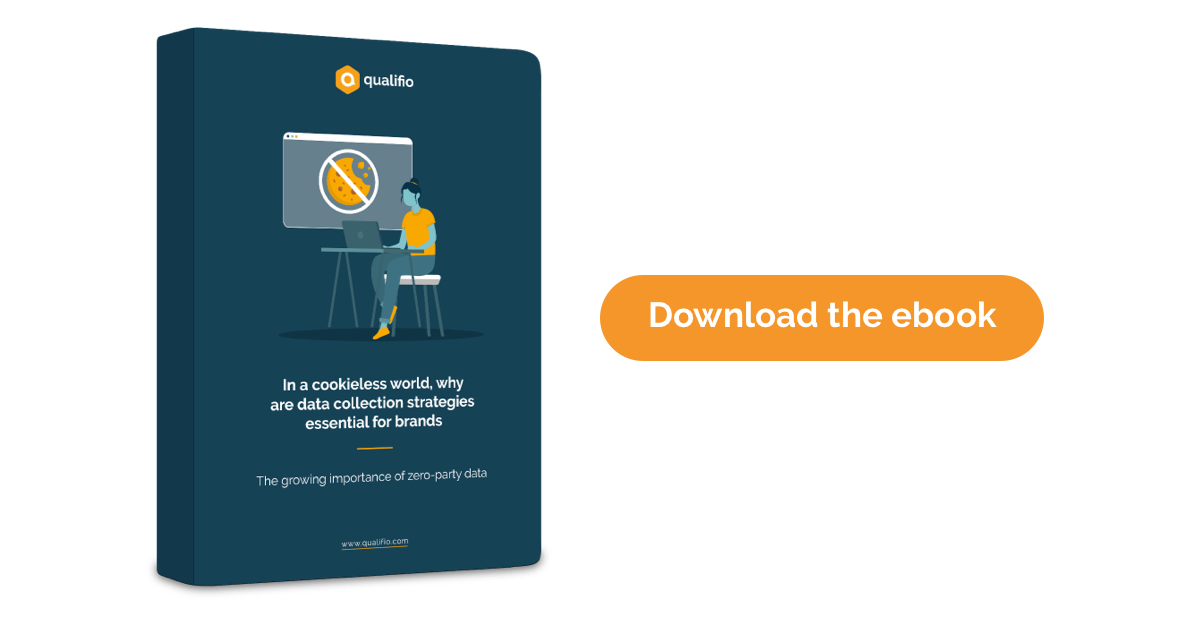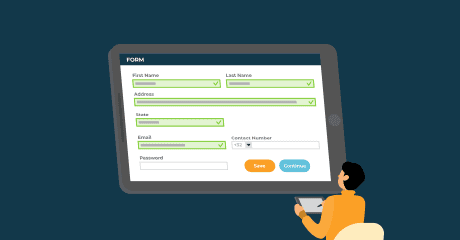How to collect qualitative data in retail? A few ideas with Freedelity and Qualifio
How to collect qualitative data in the retail environment? Answering this question is one of the biggest headaches of the digital world we live in. Of all the many buzzwords to have flown around the business and digital marketing landscapes in the last few years, “data” is surely the most wide-ranging and all-encompassing. It can also be the most fear-inducing as the prospect and pressure of gathering and processing data are colossal, especially in the current digital ecosphere where data is everywhere and collected non-stop. Qualitative data has become a rare commodity and obtaining it and using it correctly are significant challenges for many businesses.
Collecting qualitative data – how and why?
According to Gartner, there are 9 types of marketing data: online purchases, customer data, market research, competitive intelligence, sales data, customer support, the voice of the customer, product reviews and metrics. These types of data are mainly collected through 4 data sources:
- Websites are the face of the company and usually the first customer touchpoint, they gather useful information such as who is visiting your website, where they come from, what they’re looking for and how long they’re staying.
- Social media platforms are a great way to engage with consumers and can be a great tool for analysing demographics, such as the age, gender and location of an audience.
- Lead generation is the process of stimulating and capturing interest from potential customers.
- Return on investment (ROI): understanding the revenue that is being generated by the different forms of marketing actions that have been carried out will improve future decision-making strategies.
So with 9 types of data coming from 4 different sources, it’s easy to see how complicated it can be to navigate smoothly through the sometimes murky pool of data and analytics. There is also such a thing as too much data – many companies have the feeling that they don’t need more of it, but they want to know how to get more value out of the data they already have.
“Your brand is strong, attractive and in possession of a lot of data. Stop relying on complex, non-transparent AdTech ecosystems and be creative. Context and content are kings. You don’t need tons of data: starting to make better use of the data you already have access to is already a real challenge! Understanding the consumer who is tired of not knowing where their data is being stored and used is the best strategic and long-term option you can take.”
– Olivier Simonis – Qualifio, Co-founder and Chairman of the Board
The retail sector, where data is collected on a particularly vast scale, with almost unrivalled velocity and variety, is one of the most impacted sectors when it comes to managing data efficiently. The data collected ranges from buyers’ purchasing habits, to monitoring competitors’ prices, to the modes of payment used in store and online, to stock takes and quality checks. And the amounts of data collected daily in Retail are truly mind-boggling: Walmart alone generates 2.5 petabytes of data hourly, just from customer purchases – and considering that one petabyte is the equivalent of one million gigabytes (GB), that’s a lot of data!
The following list covers the main challenges that companies are facing when managing their data :
- Collecting accurate and identifiable data that can then be converted into useful insights. This can be both time consuming and costly so it is highly important to only process data that is strictly necessary.
- Managing data arriving from disparate systems so that it is centralised and actionable.
- Making sure that the data has been collected in a secure and compliant manner.
- Earning the consumer’s trust by not only ensuring their data is safe and used in compliance with any local laws and regulations, but also offering something in return for the exchange of data.
- Using the data they have collected to then produce the right insights, in a timely manner. There is absolutely no point collecting data for it to then sit in a file on a server without being processed and used.
One of the most popular mantras when it comes to data collection and processing is “keep it simple”. The simplest solutions will often be the best. A consistent and carefully planned data collection strategy will improve the quality of data, user experience, data safety and ultimately lead to better sales conversion.
There are 3 main solutions for collecting and processing centralised and unified data:
- Customer relationship management (CRM) tools are customer-facing and used to manage and nurture interactions with customers and prospects. The goal of a CRM is simple: to improve a company’s business relationships, in order to grow the business.
- Data management platforms (DMP) are unifying platforms that collect, organise and activate audience data from multiple sources. As we’ve discussed earlier in this article, raw data is pretty useless, it needs to be sorted and converted into a usable and understandable format – and that’s where a DMP is powerful. DMPs are particularly useful in the case of ad tech as they collect unstructured data from multiple sources and turn it into audience insights and segments that can be used for targeting adverts and for personalisation.
- Customer data platforms (CDP) are defined by Sitecore as “dynamic multi-taskers that are tirelessly working behind the scenes to manage, process and convert data into meaningful customer experiences”. So it is a tool that unifies customer data into one place. A CDP provides a 360° view of the customer’s profile.
Most companies nowadays rely on at least one of these tools, if not a combination of the three. Neither of them can fully substitute another and neither is better than the others – the choice of tool will depend on each company’s specific needs in terms of marketing and data strategies.
How Qualifio can help
An additional bump in the road to collecting qualitative data is the upcoming disappearance of third party cookies, expected in the next couple of years. Companies will therefore no longer be able to rely on third-party cookies to learn more about their consumers and audience and will have to find alternative strategies.
One of the front-running solutions that many experts are recommending is the use of first- and zero-party data. These types of data involve information that the consumer shares with the brand they’re interacting with. On one hand, first-party data is collected by the website they’re visiting and is usually necessary in the case of a purchase, so the user shares information such as their language preference, their gender, their address or their date-of-birth. On the other hand, zero-party data is voluntarily shared by the user with a company, with the expectation that this will improve their experience. For most companies, they already have first-party and zero-party data in their systems, accumulated over the years. The key to surviving in a cookieless world will be to harness the power of these types of already available data, by having well-thought out and efficient data strategies in place that use mostly first-party and zero-party data.
The Qualifio platform was designed to break down data silos and our data collection tool can integrate with all other major business platforms. In addition, the Qualifio tool allows the creation of more than 50 interactive marketing campaign formats, which facilitate the collection of compliant and secure data.
An integration with Qualifio will automatically transfer data from our tool to your other marketing and data apps. This means that your data will be shared with everyone who needs access to the data, and that they’ll have everything they need at their fingertips. Having an integration with Qualifio also means that all data is collected, stored and shared across your organisation, in a consistent manner and will lead to richer, more personalised interactions with your customers and prospects.
Read more about how Qualifio can help with data collection in these examples: Tifosi , RTL & Lotame, Bisnode and HighCo Data
Interview with Eric de Bellefroid, CMO at Freedelity
Curious to know more about how to collect qualitative data, we spoke to Eric de Bellefroid, CMO at Freedelity the Belgian platform for collecting and processing personal data. Founded in 2009, when Belgium was a pioneer in the field of electronic identity cards, the company currently offers 2 platforms: MyFreedelity, a digital wallet for consumers, and CustoCentrix, a platform dedicated to actors in the retail sector.
“Our added value consists in facilitating and accelerating the collection of personal data at the point of sale in order to allow retailers to get to know their customers better and develop a more personalised marketing relationship with each of them.”
Eric de Bellefroid – CMO, Freedelity
Qualifio: Could you briefly present the solutions you offer to consumers and to the retail sector?
Eric de Bellefroid: Freedelity’s solution offering revolves around 5 pillars:
- CustoCentrix: the consumer data platform that links spending data with the identity data of each consumer in order to activate the customer relationship.
- The Freedelity file which pools together common personal data between CustoCentrix users. This is what makes us so unique on the Belgian market because the Freedelity file gathers the personal data of 6,640,000 adult consumers living in Belgium. It is thanks to this pooling that our clients benefit from very high quality databases that are effortlessly kept up-to-date.
- MyFreedelity: the consumer-facing portal and mobile application that simplifies GDPR compliance and provides an additional communication channel to retailers.
- Kiosks and API‘s to facilitate consent collection and integration with POS systems, e-commerce and marketing automation solutions.
- We also offer data quality solutions to companies wishing to make their data sources more reliable. In particular downstream of data collection actions using Qualifio.
Q: What are the main needs of the retail industry that your solutions address?
EdB: We provide them with a quality marketing database that is centralised, rich in information, automatically updated and easy to activate and animate. This makes it easy to collect email addresses and consents for marketing purposes.
Retailers also have access to greater documentation of their sales, in numbers and amounts, effectively linked to consumer profile data. Our tools give them a unified view of their consumer behaviour across all sales and communication channels, and we also offer out-of-the-box solutions for audience segmentation, creation and monetisation.
These players therefore have in hand effective methods for measuring the ROI of their promotional actions and direct marketing.
Q: How are your solutions and Qualifio complimentary solutions?
EdB: Qualifio is an interactive marketing solution that is very complementary to CustoCentrix. In addition to gamifying the customer relationship and animating key moments around the organisation of competitions, it allows the collection of declarative data that is complementary to purchases.
Furthermore, Qualifio is a formidable solution for collecting consumer data on digital channels. For example, downstream of actions on social media or via sponsorship mechanisms. Qualifio is an ideal complement to CustoCentrix in order to diversify and intensify data collection, but also to support promotional actions and to animate customer paths.
Q: What are for you the key elements in the efficient and secure collection of data that the retail players must take into account?
EdB: I would say that there are 3 key elements to be put in place:
- 1️⃣ A single repository for managing identification data, all channels combined, guaranteeing the uniqueness of each profile as well as the quality of the data collected.
- 💪 Consolidate the data necessary for customer knowledge in a reference system. This is the vocation of a “Customer Data Platform”.
- 🛣️ Have a pragmatic roadmap in place: progress step-by-step on the basis of solid foundations by integrating a “Privacy By Design” approach at each phase of the roadmap.
Q: And what should they absolutely avoid ?
EdB: In my opinion, there are 4 things to avoid at all costs in a qualitative data collection process:
- ❌ Going too fast and skipping steps.
- 🛠️ Multiplying tools unnecessarily by starting from a seemingly random list of features that has come from, for example, the expression of needs from the compilation of best practices put forward by editors, analysts and consultants.
- 🏛️ Starting without solid foundations in terms of data quality and traceability of processing.
- 🔐 Underestimating the GDPR compliance aspect and the underlying expectations of consumers in terms of protection of their personal data.
Q: What do you think is the impact of the disappearance of third-party cookies on the retail industry?
EdB: This will finally and rightly reinforce the focus on the importance of first- and zero-party data. This is a very good thing in terms of privacy and sovereignty over the processing of personal data. It is also an important momentum in the relationship between manufacturers and retailers.
Q: What are currently your biggest challenges at Freedelity?
EdB: At present and in the near future, the first challenge remains the quality and relevance of the data collected. The second is the competence and experience of the teams in charge of developing the customer relationship and experience. And the third is measuring the ROI of marketing and advertising investments to support budget allocation decisions.
Q: What are the best examples you have as inspiration for others in the retail sector?
EdB: Personally, I am impressed by the speed with which several of our clients have built up large databases, with impressive email opt-in rates. I am also impressed by the way some of our clients are using this data in their supplier relationships to implement trade marketing or co-marketing initiatives.
Conclusion
In today’s business and marketing landscape, more data is being collected about just about everything than ever before. But all of this data needs to be made sense of, in order to be turned into valuable and accurate insights. Ideally, all of the data collected by a company needs to be brought together in one place, to provide a centralised and easily legible overview.
There are many challenges facing companies when collecting data in an efficient and effective way but the possibilities and opportunities are tremendous. Even the end of third-party cookies, that could be seen as a complete disaster, is actually a blessing in disguise and an incredible opportunity to review and revolutionise the way in which businesses collect data and use the data they already have. So there are solutions out there, that mainly involve careful planning, the implementation of innovative and ground-breaking tools, with the right mix of human talent and knowledge.
Data is the next technological bandwagon, so it is worth investing in the right solutions and strategies, to not miss out on valuable insights.








